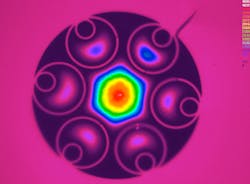Low-attenuation hollow-core fiber could herald more cost-effective data centers and 5G networks
In hollow-core optical fibers, the conventional glass in the core is replaced by a gas or vacuum. These fibers, with a "holey" center, have attracted scientists owing to their faster light speed, giving less information delay—important for data centers, 5G mobile communications, and driverless vehicles. Hollow-core fibers (HCFs) also have the potential for lower loss and higher data transmission capacity than conventional all-solid glass optical fibers. Despite predictions, the use of HCFs in optical communications has to date been severely limited by their relatively high optical loss.
A breakthrough to be reported this week by the University of Southampton's Optoelectronic Research Centre (ORC; Southampton, UK) at ECOC2018 in Rome, Italy could herald the creation of larger and more distributed data centers and more resilient and cost-effective 5G networks. The postdeadline paper, "Record Low-Loss 1.3dB/km Data Transmitting Antiresonant Hollow Core fibre," is a joint initiative between the ORC, through the European Research Council (ERC) "LightPipe" project, and Lumenisity (Romsey, UK). It reports the world's lowest optical signal attenuation in a data-transmitting HCF. The result is particularly significant, as it breaks the previously recorded HCF attenuation level of 1.7dB/km, reported as long ago as 2004.* The results have been enabled by a novel fiber structure invented at the ORC** for which modeling predicts offers future losses as low as, or better than, standard silica fibers.
The Nested Antiresonant Nodeless hollow-core fiber (NANF) developed by the Southampton team incorporates an arrangement of 12 carefully positioned glass capillaries with a wall thickness of just 1 µm. The tubes surround an empty central region and form a hollow pipe within which the light is guided.
"[T]he experiments agree well with numerical simulations, giving us confidence in predictions that the capacity of the fiber could be increased by a further factor of two and the loss decreased by a factor of ten through design and fabrication improvements," says Professor Francesco Poletti of the Optoelectronics Research center.
Applications of this new technology will be explored in partnership with a range of academic and industrial project collaborators through the EPSRC-funded Airguide Photonics program.
* B.J. Mangan, et al., Proc. OFC 2004, PD24.
** F Poletti, Opt. Express 22, 23807-23828 (2014).
Source: ORC

John Wallace | Senior Technical Editor (1998-2022)
John Wallace was with Laser Focus World for nearly 25 years, retiring in late June 2022. He obtained a bachelor's degree in mechanical engineering and physics at Rutgers University and a master's in optical engineering at the University of Rochester. Before becoming an editor, John worked as an engineer at RCA, Exxon, Eastman Kodak, and GCA Corporation.
